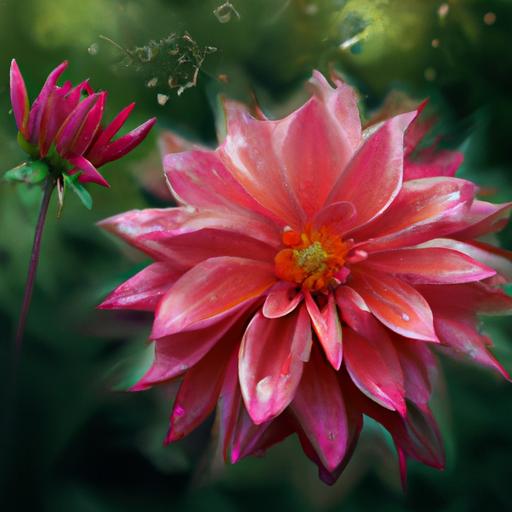When it comes to adding color and beauty to a garden, few flowers compare to the stunning effects of dahlias and peonies.
With their vibrant colors and unique shapes, these two flowers have long been favorites of gardeners around the world.
But what exactly is the difference between a dahlia and a peony? In this article, we’ll explore the differences between these two beautiful blooms, from their blooming times and color variations to their soil and hardiness requirements.
Read on to discover what sets these two flowers apart and which one is best for your garden.
Table of Contents
Short Answer
Dahlias and peonies are both flowering plants, but they differ in many ways.
Dahlias are annuals or perennials, depending on the variety, while peonies are perennials.
Dahlias are known for their bright colors and wide variety of flower shapes, while peonies are often white or pink and have large, cup-shaped blooms.
Dahlias need full sun and moist, well-drained soil, while peonies prefer partial shade and slightly moist soil.
Overview of Dahlias
Dahlias are a vibrant garden flower that comes in a variety of sizes, shapes, and colors.
The most common type of dahlia has a central spike surrounded by petals that grow outward in a star-like shape.
Some varieties of dahlia are much larger than others, and can reach up to two feet in diameter.
Dahlias are native to Mexico, Central America, and Colombia, but are now cultivated all over the world.
Their vibrant and eye-catching blooms make them a popular choice for gardeners and flower lovers alike.
Dahlias typically bloom from early summer to early fall, and the blooms can last up to two weeks.
They can be used in a variety of ways, from cut flowers in arrangements to beds of colorful blooms.
Overview of Peonies

Peonies are a classic garden flower that are beloved for their beautiful bloom.
They have a distinct round center that looks like a puffball and petals that spread outward in a ruffled pattern.
Peonies come in a variety of colors including pink, white, yellow, and red.
They also have a sweet and delicate scent that is often likened to the smell of roses.
Peonies typically bloom in the spring, although some varieties can also bloom during the summer and fall.
Peonies are hardy plants and can survive winter temperatures in most climates.
They are also relatively easy to care for in terms of needing little maintenance beyond regular watering and pruning.
Peonies make a great addition to any garden, providing a beautiful and vibrant pop of color.
Comparative Visual of Dahlias and Peonies
When it comes to dahlias and peonies, their visual differences are quite striking.
Dahlias have a spiky center that is surrounded by petals that grow outward in a star-shaped pattern.
The petals can range in color from white to pink to purple.
Peonies, on the other hand, have a more rounded center that looks like a puffball and petals that grow outward in a ruffled pattern.
The petals of peonies can also range in color from white to pink to purple.
To give a better visualization of the difference between these two flowers, here is an example of a dahlia and a peony side-by-side.
The dahlia has the spiky center and star-shaped petals, while the peony has the puffball center and ruffled petals.
This comparison makes it easier to identify the difference between these two beautiful flowers.

Comparative Overview of Blooming Times

When it comes to blooming times, dahlias and peonies couldn’t be more different.
Dahlias typically bloom from early summer to early fall, while peonies bloom in the spring.
This means that gardeners can enjoy the beauty of these two flowers in different parts of the year.
Dahlias bloom for a longer period of time, giving gardeners the chance to admire them for several months.
This means that gardeners can enjoy the same patch of dahlias for much longer than peonies.
On the other hand, peonies bloom for a shorter period of time, but the flowers are often larger and more showy than those of dahlias.
The blooming times of the two flowers also depend on the climate and the specific varieties.
Dahlias can be grown in both cool and warm climates, while peonies are best suited for cooler climates.
Dahlias also come in a wide variety of colors, shapes, and sizes, while peonies are typically white or pink.
The blooming times of these two flowers also depend on the environment.
In hotter climates, dahlias may bloom earlier than in cooler climates.
The same is true for peonies, which may bloom a bit later in warmer climates.
Regardless of the climate, both dahlias and peonies are popular and beautiful garden flowers that will add color and texture to any garden.
With careful planning, gardeners can enjoy the beauty of these two flowers for months at a time.
Comparative Overview of Coloring
When it comes to the differences between dahlias and peonies, one of the most noticeable is in their coloring.
Dahlias come in a wide variety of colors, from warm shades like yellow, orange, and red to cooler tones like purple, white, and pink.
The petals are usually all the same color, but some varieties have two-tone petals with different colored tips.
Peonies, on the other hand, are typically found in shades of pink and white, and they often have a darker center.
While both flowers may have some darker accents, dahlias tend to be a bit more vibrant in color.
Comparative Overview of Plant Hardiness

When it comes to plant hardiness, there are some key differences between dahlias and peonies.
Dahlias are typically more hardy than peonies, and can tolerate some cold temperatures.
They are typically more tolerant of drought and can thrive in areas with poor soil conditions.
Peonies, on the other hand, are less hardy than dahlias and require regular watering and well-drained soil in order to thrive.
They are also more susceptible to frost and colder temperatures and may require some extra protection in the winter months.
In addition, peonies typically require more maintenance than dahlias, as they need to be pruned and deadheaded regularly in order to promote healthy blooms.
Comparative Overview of Soil Requirements
When it comes to soil requirements, both dahlias and peonies have similar needs.
Both of these flowers prefer well-draining, loose soil with plenty of organic matter.
To ensure that the soil is loose enough, it’s a good idea to add a layer of compost or aged manure before planting.
Ideally, the soil should be slightly acidic with a pH between 6.0 and 6.5.
In addition, dahlias prefer soils that are slightly higher in potassium, while peonies prefer soils that are slightly higher in phosphorus.
Both flowers require regular watering, however, dahlias need more frequent watering than peonies, as they are prone to wilting in dry conditions.
It’s also important to note that dahlias are more tolerant of heat and drought than peonies, so they may need less water in some climates.
Lastly, both of these flowers should be fertilized regularly, although the type and amount of fertilizer may differ depending on the soil conditions and the specific flower variety.
Final Thoughts
Now that you understand the differences between dahlias and peonies, you’ll be able to choose the perfect flower for your garden.
When deciding which flower to plant, consider the bloom time, color, hardiness, and soil requirements.
With a little bit of research, you can find the perfect flower for your yard!

